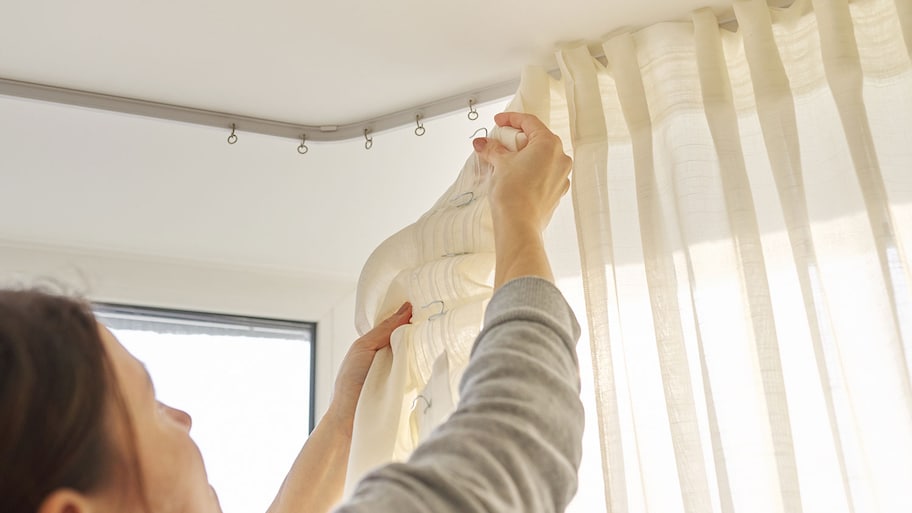Which Home Projects To Put On Your To-Do List First After Moving
Cross off one project at a time to make your to-do list easy to tackle


Purchasing a new home is thrilling, but once the novelty wears off, it can be hard to know what to do next when you’re faced with a mountain of unpacked boxes and an ever-growing to-do list. Once you’ve called the utility companies and changed your address, it may seem like every other project is equally urgent.
No worries: We’ll fill you in on the projects to tackle immediately so you can start making your house a home and what projects can take a backseat on your agenda.
Before You Move In
Ideally, there are a few projects that should be completed as soon as you receive the keys to your new home. Some of these projects are due to safety reasons, but there’s another component to keep in mind—ease. Some projects are just easier to accomplish before moving boxes and furniture arrive. Below are a few projects to put on the top of your list, before you move into your new place:
Add Some Color
Since you have your own color preferences, it's likely that you'll want to repaint your new home to reflect your personality. While this can certainly be done at any time, it's undoubtedly easier to do if there's no furniture and moving boxes in your way.
If you choose to paint yourself, know that there are some tips to painting your walls to make the process smoother. If taking on this task seems like another endless task on your to-do list, you can instead opt to hire a local interior painter to take on this task for you while you get moved in.
If painting isn’t in the cards right now, you can plan for the future by picking up paint swatch cards at your local paint store to see how different colors work in your new home. See how these colors translate with the daytime sun; when you’re ready to paint, you know what would work best.
Replace Flooring
Similar to painting your new house, in an ideal world, if you’re planning on giving your home a new look, you’d swap out flooring before moving in. Even if you’re not sure of your long-term plans, you’ll want to remove wall-to-wall carpeting in bathrooms, for instance—this formerly popular practice promotes mold growth. If staircases are bare, cover them with runners for safety.
If you’re not sold on what type of flooring should go where, you can consult a local flooring company to go over your options. New floors in a new home can seem like a monster task, but taking it one room at a time can make it seem less scary.
Put in Molding
Another optional project to add character and make your home look more finished and upscale is to install wall, ceiling, floor, door, and window molding. To save time, if you’re planning on taking on this project, consider whether you’ll install crown, casing, or chair rail molding prior to moving in. That way, once you get the keys, you can get right to work before unpacking the moving boxes.
Make it Sparkle
Hire a cleaning service to make your new home spick and span. Again, this should ideally be tackled before you actually move in. Local cleaning services will be well aware of everything that goes into cleaning a home for new owners, as this is a common service, but if you have any special requests, be sure to note them. While this task can definitely be done without a service, it might be a huge undertaking (depending on the condition the home was left in) and could take up a large chunk of your moving-in time.
Within The First Month
You’ve unpacked (most of) your boxes and are finally settling into your new home. You’ve handled the most urgent tasks on your to-do list, but now what? These next projects are still essential to get to shortly after moving but can happen within the first week of settling in:
Install a Security System

If your new home doesn’t already have an alarm, hire a home security service near you to install a security system. Ideally, it will include smoke alarms and carbon monoxide detectors—check to ensure all these devices are working properly and change their batteries, if necessary. These systems can deter potential thieves, but most also allow you to remotely monitor your home while away, offering additional peace of mind.
Cover the Windows

Most homes don't come with window coverings, or if they do, it’s a good possibility that they are worn or not exactly what you want. Take this time to invest in quality curtains or another type of window covering that you’d like in your home.
If purchasing new window coverings at this stage of the game seems overwhelming—after all, there are a lot of choices—you can put up temporary window treatments, like paper blinds, in the meantime. These temporary measures ensure you’ll be able to take your time to find what you’re looking for, not to mention it gives you time to take some measurements.
Fix Any Issues From the Inspection
Take care of any urgent issues that your home inspector identified. If your new property has radon, put in a radon mitigation system. If your new home’s water is hard, consider installing a softening system. Take care to hire a pro to remove any mold or asbestos if you know either is present in your new home.
Although the inspector should have checked the plumbing, you might still want to reach out to the gas company to look at all the home’s lines and connections. Similarly, consider calling an HVAC technician near you to service your AC or heat, depending on the season.
Upgrade the Electrical System
Perhaps during the time you’re fixing any inspection issues, you’ll want to have an electrician ensure that all the relevant outlets are ground fault circuit interrupters (GFCI). They should also check that the wiring is safe and add new outlets, if necessary. If the home’s circuit breaker box is outdated, you might want to replace it to ensure you are up-to-date with any codes in your area. While the electrician is on-site, have them install any light fixtures you need while you’re making minor interior upgrades to your home.
Call Pest Control
Only a few things are worse than moving into a new home and finding that you have a bug problem. Whether it’s ants, mosquitos, or other pests, these bugs can undoubtedly put a damper on your day.
While you might be tempted to call a pest control professional near you right away, giving it a week or two to see if the problem resolves itself might be worth it. After all, bugs might make a special appearance when the doors are all open to move in boxes and furniture. If you're still having a bug problem after a week or two after move-in, it might be best to call in a pro.
Maintain the Outdoors
Outdoor maintenance has an interesting timeline, depending on the season that you move in. We suggest attacking this project within the first week of moving into your home, especially if your home has a pool. Calling a pool company near you to service it early is important—it can take up to two weeks from opening to being swim-ready.
Additionally, taking some time to inspect and clean your gutters and replacing them if needed is an important step in outdoor upkeep. However, if your move happens to be during a harsh winter month, these outdoor tasks wait to be taken care of until an appropriate season, like spring.
Within The First Six Months
Moving into a new home can bring on many feelings—excitement, nervousness, and even some stress. With all the commotion that moving into a new place brings, there are a few projects that you should consider waiting on. It’s important to note, however, that every house is unique—any repairs that could impact the integrity of your home should be moved to the top of your list and should be dealt with as soon as possible.
Hire a Plumber
Although by no means a necessity, hiring a plumber to replace your toilets could make a lot of sense—especially if these fixtures are old, dingy, or rusted. Unless your toilets and other plumbing aspects of your home are not in working order, this project can be put off for a few months to allow you to take care of other important issues.
While the plumber is there, you can have them inspect your systems and get quotes for any upcoming projects where you may need their help, such as replacing pipes and connecting gas lines.
Focus on Landscaping
There’s no doubt that landscaping enhances your new home’s appearance. Who doesn’t love coming home to beautiful flowers, a gorgeous patio to host on, or a relaxing swimming pool to take a dip in? The cost of landscaping your new home varies greatly depending on the type of project you want, which is why it’s essential to wait on this project for a while after moving in. Consider what you want to add to your yard, both front and back, to make your new place your own sanctuary.
First Year and Beyond
After living in your new home for about a year, you know what the best parts of your home are and what needs some TLC. You know your home’s personality and have a pretty good idea if any larger projects need to be done to make it truly perfect. Take on these larger projects as you close out your first year:
Large Renovations
Large renovations, like remodeling a kitchen or bathroom, should fall lower on your to-do list. This gives you time to learn what you love or dislike about your space, what’s necessary, and how to improve your area. A good rule of thumb is to wait at least six months to a year to fully commit to new renovations—otherwise, you might be spending thousands of dollars on a project that you don’t fully love.
Make Home Upgrades
Since you just moved into a house that’s new to you, it's good to learn how old certain features are, like the roof, windows, and furnace. These things have a certain lifespan, and knowing how close you are to them is vital for your budget. After you’ve lived in your home for a while, you can start to upgrade those key features of your home that need a makeover. If taking on whole-home upgrades is nerve-wracking, consider upgrading one part of your home at a time.
Reseal Your Driveway
It’s unlikely that you think about your driveway very often, but did you know that if you don’t reseal it every 2-3 years, it can deteriorate? Depending on your climate, sun, snow, and even rain can damage your driveway. To mitigate damage and keep your driveway that leads to your home looking in tip-top shape, connect with a local driveway sealer to discuss this project.
